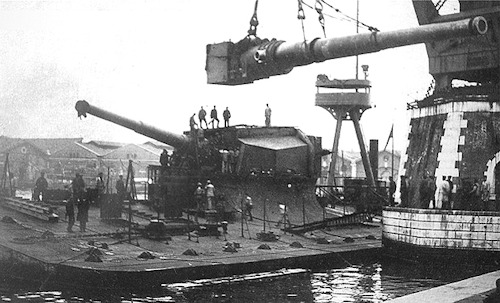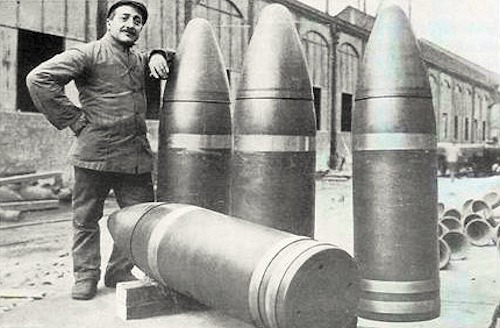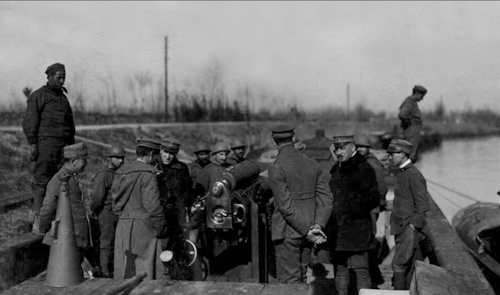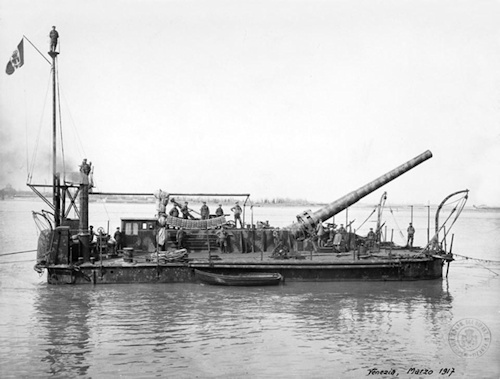When the First World War broke out, the Royal Navy had the main task in the Adriatic, to maintain the maritime domain, and to protect the coasts. Along the coasts, armed trains were equipped, which shuttled from Ravenna to Brindisi. The 20 July with the surviving crew of the cruiser Amalfi, the first terrestrial lagoon battery was created by 76 / 17 operating with the Perugia Brigade (129 ° and 130 ° infantry), on the side of the sea in the 3rd Army, as an artillery support in the area between the lagoon of Venezia and front of the Isonzo. In the fall, 97 artillery pieces of various caliber were in action, which constituted a real regiment (grouping) in the VIIth Army Corps. As part of these complex operations, special naval vessels were created, set up to provide support for the land forces: the pontoons or armed rafts, which for the characteristics of the navigation of the coastal area, it was necessary to prepare a number of boats to low draft on which they were mounted large artillery gauges and anti-aircraft pieces. Some of these barges had been reconverted to military use by the mercantile and fishing vessels, other pontoons had been built from scratch by the Venice Arsenal. From the 1916 were prepared from the arsenal of Venice several floats both in iron and wood, armed by 60 to 100 tons.
The lagoon territory characterized by one thick network of channels and waterways that cross the "Litoranea Veneta", which naturally starts the lagoon of Venice, continues towards the port of the Lido and crossing canals touches the river Sile. And, after a journey of about 127 km, it flows into Punta Sdobba in the Gulf of Trieste. It consists of stretches of artificial canal that alternate with natural features obtained from the rivers Sile, Piave, Livenza, Lemene, Tagliamento, Stella, Isonzo and the lagoons of Caorle, Marano and Grado. Over time it has been a fluvial navigation system of great importance and development for transport and trade from the Gulf of Trieste to that of the Venice lagoon. The characteristic of that war, led the Royal Navy to play alongside the army, an important action, which involved a direct cooperation on operations on the land front.
 In October of the 1917, four large self-propelled pontoons were in service: Monfalcone, Corso, Cucco e Vodice, and two tows, brave e Sturdy. Among the most powerful and powerful were the so-called "monitors" Faà di Bruno (Photo) e Alfredo Cappellini. Built in Venice by shipyards Arsenal, two pontoons (large wooden or steel float, with a very robust deck and a flat bow and stern. It can be towed or self-propelled, and can be equipped with powerful cranes or chariots; is used in harbors, arsenals, shipyards), had received the large calibers originally intended for the battleship "Caracciolo", never built." It was two cannons from 381 / 40 with a useful range of over 27km and project from 884 Kg for a firing rate of about 3 strokes / minute. The two pontoons entered service at the end of July of the 1917 during the eleventh battle of the Isonzo they were employed against some Austrian posts of the lower Isonzo. The defeat of Caporetto saw the retreat of the pontoons of the Royal Navy to defend the new front line slipped beyond the Piave. And the two monitors were hooked each to a trailer for the transfer to Ancona, where they would have to strengthen the city's coastal defenses. While the convoy crossed the coast of the Marches, at the mouth of the river Esino was hit by a violent storm. Routes towing from the fury of the sea, the Fàa di Bruno was stranded near Marotta. For the Caps the fate was tragic: the pontoon began to load more water than the on-board pumps could aspire. A little later he leaned on his side and the weight of the pieces from 381 did plunge in a few minutes. Most of the crew perished at sea, including Commander Pesce. The Faà di Bruno it will be secured by 11 girls di Marotta who, challenging the fort with a small boat, will be able to moor the armed pontoon and then receive the bronze medal of the Navy. At the end of the Great War the Faà di Bruno he will be put back, to be used again at the outbreak of the Second World War a GenoVa in the when it was assigned to the defenses of the port with the initials GM 194.
In October of the 1917, four large self-propelled pontoons were in service: Monfalcone, Corso, Cucco e Vodice, and two tows, brave e Sturdy. Among the most powerful and powerful were the so-called "monitors" Faà di Bruno (Photo) e Alfredo Cappellini. Built in Venice by shipyards Arsenal, two pontoons (large wooden or steel float, with a very robust deck and a flat bow and stern. It can be towed or self-propelled, and can be equipped with powerful cranes or chariots; is used in harbors, arsenals, shipyards), had received the large calibers originally intended for the battleship "Caracciolo", never built." It was two cannons from 381 / 40 with a useful range of over 27km and project from 884 Kg for a firing rate of about 3 strokes / minute. The two pontoons entered service at the end of July of the 1917 during the eleventh battle of the Isonzo they were employed against some Austrian posts of the lower Isonzo. The defeat of Caporetto saw the retreat of the pontoons of the Royal Navy to defend the new front line slipped beyond the Piave. And the two monitors were hooked each to a trailer for the transfer to Ancona, where they would have to strengthen the city's coastal defenses. While the convoy crossed the coast of the Marches, at the mouth of the river Esino was hit by a violent storm. Routes towing from the fury of the sea, the Fàa di Bruno was stranded near Marotta. For the Caps the fate was tragic: the pontoon began to load more water than the on-board pumps could aspire. A little later he leaned on his side and the weight of the pieces from 381 did plunge in a few minutes. Most of the crew perished at sea, including Commander Pesce. The Faà di Bruno it will be secured by 11 girls di Marotta who, challenging the fort with a small boat, will be able to moor the armed pontoon and then receive the bronze medal of the Navy. At the end of the Great War the Faà di Bruno he will be put back, to be used again at the outbreak of the Second World War a GenoVa in the when it was assigned to the defenses of the port with the initials GM 194.
 At the time of Caporetto, two large self-propelled pontoons were being set up in the arsenal of Venice Monte Santo and Sabotino, with a 381 mm cannon each.
At the time of Caporetto, two large self-propelled pontoons were being set up in the arsenal of Venice Monte Santo and Sabotino, with a 381 mm cannon each.
The four self-propelled pontoons of the class Monte Grappa, had similar characteristics to the previous ones, except for some variants that improved the complex. Metal hull, vertical walls, flat bottom, straight bow and stern, piece of artillery from 381 mm. The hull was divided into seven main compartments by six watertight transverse bulkheads. Which housed the oil and oil depot, engines, motor pumps and electrogenerator, cannon well, crew accommodation and food storage. Equipped with a bridge with a superstructure platform for a range, and a look-out tree equipped with a station for the telemeter and a coffa for the look-out. The engine system consisted of two two-stroke Fiat diesel engines from 350 Hp. Also part of this nucleus of armed vessels, even the converted bets Luigi Mina e Umberto Missina, (float, usually with steel hull, without propeller, with a capacity of up to a few hundred tons, for transport of fillers, mud, etc. in ports or near the coast), which performed the task of pontoons for the use of braking balloons, which served as observation posts to direct the shooting of armed pontoons. All these armed "ships" contributed to the control, and to the defense of the "Litoranea Veneta", of the Piave and of Venice.
Participated in this defense:
Alfredo Cappellini - Faà di Brunio
 Monfalcone - former Austrian pontoon, captured in the 1915; Major de Rosa, Captain Bianchini, Robusto Valente and Captain Casotto - iron pontoons
Monfalcone - former Austrian pontoon, captured in the 1915; Major de Rosa, Captain Bianchini, Robusto Valente and Captain Casotto - iron pontoons
Monte Santo - ex Jella, Sabotino - ex Tina, Austrian cargo barge (large sailboat used in Chioggia and in the Venetian lagoons for transport, materials, or goods), captured, transformed, and classified gunner in the 1921. In the 1929 after the radiation, it was transformed into an anti-aircraft floating battery. Vodice, Karst, Cucco former Austrian cargo boats captured and transformed. In the 1921 classified gunner.
Pasubio - ex Austrian floating barge, (usually without propeller, of generally modest extent, used mostly in ports for the transport of water, naphtha, waste, general cargo), captured and transformed. In the 1921 classified gunboat. Frog from 1 to 3 - Rana from 1 to 4 ashes for ashes, prepared after the October of 1917, and used for the defense of Venice and the low Piave.
Monte Grappa, Monte Cengio, Montello, Monte Novegno derivatives from Monte Santo and armed with pieces from 381 mm. In the 1921 classified gunner.

Padus (Photo) - ex Austrian barge (wooden or metal barge with almost flat bottom, sail or motor or more often without own propulsion means, used for the transport of goods and people, along rivers and waterways), captured and converted.
Luigi Mina, Umberto Missina - betta (floating, usually with a steel hull, without propeller, with a capacity of up to a few hundred tons, for the transport of filling materials, mud, etc. in ports or near the coast), converted into armed pontoons for balloons "dragon".
Trabaccolo 31 and San Marco (two-masted sailing ship with sails to the third, polaccone and contropolaccone, sometimes the aft mast, rather than the sail to the third, carries a mainsail, used in the Adriatic for coastal traffic and fishing).
I.S. 7 e IS 10 wooden pontoon boats for the transport of coal. GB 95, GB 114, GB 120, GB 133, GB 233, GB 234 - non-pontoon wooden coal boats. GB337 - pontoon coal boat.
GF 257 peata (wooden boat, Venetian variant of flat or barge, large medium-sized boat with flat bottom, used once in the Venetian lagoon for the local transport of large cargo, building material and similar, for the transport of coal). GF 354 hereinafter referred to High. Top from 1 to 9, e Beaver from 1 to 8, wood peas prepared after the October of 1917, and used for the defense of Venice and the low Piave.
Sdobba e Tiger, pontoon boats for the transport of coal, prepared after October of the 1917, and used for the defense of Venice and the lower Piave.
1 seal (Eg Palmiria), 2 seal (Eg Zoggello), 3 seal (Eg Griselda), 4 seal (Eg Esterina), 5 seal (Eg Carletto), venetian burci (boat used for inland navigation, also called barcon.Fitted with two trees to be pulled down under the bridges.An each mast was hoisted a sail to the third, the range varied from 800 to 2.500 qli. were: 35 length m, 7 width, 2-2,20 m height, and 1,80-2,10 full load draft m). In the sixteenth century, the burcio was a unit of measurement, corresponding to 600 masteli (1 mastelo = 75 liters), prepared after October of 1917, and used for the defense of Venice and the lower Piave
Otter 1, Otter 2, coal-fired boat.
Wolf 1, Wolf 2, boat transport materials.
Ranon 1 - 2 - 3 - 4, each consisting of two coupled landing rafts, set up after October of the 1917, and used for the defense of Venice and the lower Piave.
Ranin by 1 to 4, Raganella from 1 to 28 - landing raft, prepared after October of the 1917, and used for the defense of Venice and the low Piave.
Beech marten by 1 to 3, Bear from 1 to 5 - floating, prepared after October of 1917, and used for the defense of Venice and the Piave low.
REFERENCES
1) History of the Navy - vol 1-10 - Fabbri Publisher 1978
2) Historical Office of the Navy - Historical Almanac of the Italian Military Ships (1861-1995)
3) M. Veronesi - The pontoons armed in the First World War - Maritime magazine, January 2010












